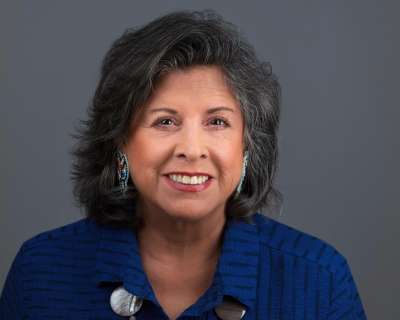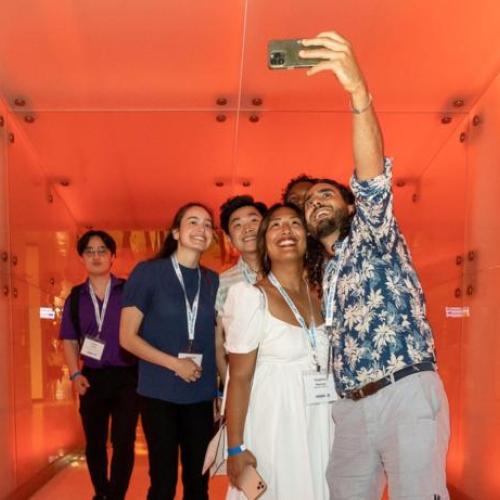October 29, 2021 | Alumni
In her own words: Dr. Cynthia Wesley-Esquimaux on being the first to study Indigenous historic trauma
By Cynthia Wesley-Esquimaux

Cynthia Wesley-Esquimaux (BA 1985 UTSC , MA 1998, PhD 2004) with her daughters and granddaughter (Photo by Kim Big Canoe, Georgina Island First Nation)
A member and resident of the Chippewa of Georgina Island First Nation, U of T Scarborough alumna Cynthia Wesley-Esquimaux (BA 1985 UTSC, MA 1998, PhD 2004) is an expert in Historic Trauma and its impacts on Indigenous peoples.
In 2013, Dr. Wesley-Esquimaux joined Lakehead University, serving as Vice Provost for Indigenous Initiatives. In 2016, she was named the inaugural Indigenous Chair in Truth and Reconciliation in Canada for Lakehead University. Dr. Wesley-Esquimaux is also an assistant professor (status only) at the Factor-Inwentash Faculty of Social Work at the University of Toronto, and is Chair of the Governing Circle for the National Centre for Truth and Reconciliation at the University of Manitoba. She additionally served as the inaugural Nexen Chair for Indigenous Leadership at the Banff Centre for Arts and Creativity.
Actively engaged in federal politics, Dr. Wesley-Esquimaux ran for Parliament representing the Liberal party in 2011, 2019 and in the most recent 2021 election. An avid mentor and volunteer, Dr. Wesley-Esquimaux co-founded a youth project – Canadian Roots Exchange – out of the University of Toronto. This year, she has volunteered to be a Partners in Leadership mentor at UTSC.
Dr. Wesley-Esquimaux’s interview has been lightly edited for clarity and condensed for length.
Education, racism and breaking through barriers
I was one of those Indigenous students who dropped out of school. I had completed grade 9 and maybe had gone into grade 10. There was so much racism at the time. It seemed like there was never an end to being called names or being centred out as being the only Native student in the class. I dropped out. I went to work, and four years later I moved to Palm Springs, California for five years. While I was in California I went back to school. I actually graduated from Palm Springs High. After that, I went to the College of the Desert, into the associative arts program. And I thought: I can do this. This is not as hard as I thought.

I applied to U of T. I was the only Native student at that time out in Scarborough until another Native student started, but he didn’t graduate. While I was there I got married, and I got pregnant with twins. It was pretty challenging.
Later, I found I did not have the grades that were necessary to get into graduate school, so I just went and argued with them. It was the time of David Foot’s book about the changing of the economy, The Pig and the Python. I just did the research and I said, ‘You have to let me in because I’m Native, and because things are shifting. We need to be retrained and educated, and I need that graduate degree.’
They let me in.
They said there’s nothing in the literature. I said let’s put it in the literature
I was [pursuing work on] historic trauma. They said, ‘We don’t know what that is. There’s nothing in the literature. You have to do something that has been done.’
I said, ‘Well then, let’s put it in the literature.’
Bubonic plagues of Europe versus the historic trauma of Indigenous peoples of Canada
For my master’s degree I did a comparative analysis of the aftermath of the Bubonic plagues in Europe and the aftermath of the epidemics on this continent — how people responded to that kind of massive death and shifting of economies, land acquisition and loss. What I really wanted to know was, why did Indigenous peoples — why did they act the way they did? Why was it so easy to get them into alcohol addictions? Why have we not been able to shake that?
When you look at what happened in Europe – which lost about 50 per cent of their population to Bubonic plagues – the same things happened. People were getting drunk and they were leaving their families and getting into all kinds of debauchery because they figured, I’m not going to live anyway. I might as well do whatever I want to do.
In the last 50 years or so, people have said, yes, we can do this healing
Indigenous peoples went through the same thing [in North America, when diseases brought by Europeans decimated communities], but the difference is this: The Bubonic plagues happened on average every 40 years. In 40 years, there’s a lot of reconstituting that can happen. Babies are born, there are remarriages, repopulation of villages, stabilizing of the economy.
But on this continent, the epidemics [like Small Pox] hit on average every seven to 14 years. Indigenous peoples kept moving from one grief cycle to the next. There was no resolution that happened over time. Now, that’s happening. In the last 50 years or so, people have said, yes, we can do this healing. We can talk about the historic trauma, we can name it.
We were in this place where we were ‘making do’ and sort of limping along. And then we had things happen like RCAP (Royal Commission on Aboriginal Peoples) and the Truth and Reconciliation Commission that reopen a lot of peoples’ trauma that they’d tamped down, which allowed them to survive. There was a lot of re-traumatization that occurred in our communities. These conversations have been very hard on people. And if seven generations went through residential schooling institutions and Indian hospitals and child welfare – and epigenetics tells us that 14 generations can be affected – then we’re not out of the woods yet.
Indigenizing Canada’s universities
In the last few years we’ve been talking about Two-Eyed Seeing, and we’ve been embedding that in the conversation. It is possible to see through a Western lens, an academic lens. But it’s also possible to look through an Indigenous Knowledge lens at the same time, and understand that the two world views don’t necessarily collide. They can be integrated.
The presidents of Canadian Universities put forward 13 principles in 2015, and those principles guide the work that the University and College systems are doing to incorporate Indigenous Knowledge into their academics.
We started this conversation off [with Canadian Universities] talking about decolonization. What I’ve since subsequently come to understand is that we can’t really talk about ‘decolonizing’ because decolonizing would mean that we have to break apart institutions and corporations and the government of Canada.
What we’re really doing is Indigenizing. We’re taking Indigenous Knowledge and Indigenous thought, philosophy, history, and we’re lifting it into places that we feel it’s important for it to be
What we’re really doing is Indigenizing. We’re taking Indigenous Knowledge and Indigenous thought, philosophy, history, and we’re lifting it into places that we feel it’s important for it to be. Whether it’s about the health systems — whether it’s about the academic institutions that are now putting in Vice Provosts for indigenous Knowledge, and directors and buildings (U of T is putting up a building at Scarborough).
Universities Canada is now in the process of revising and updating those 13 Calls-To-Action that the Universities put out. I’m a part of that committee, so I know that they’ve looked at all of them and we’ve done a report card. Where are we? What has changed? Every single program across every single part of any university has to have a level or percentage of their learning that incorporates Indigenous Knowledge.
How many of us have elders who are now a part of our Faculty — not someone we invite in once a year? How many of the schools – like Trent University – actually talked of giving elders PhD’s so that they had the cachet and the authority when they walked into a classroom that they might not have had as the Elder of a community? Things like that are important because universities are very hierarchical places.
[The Indigenous Chair in Truth and Reconciliation in Canada at Lakehead University, which I hold] is not a research chair. It is really an engagement chair. It’s probably one of the first chairs like that. I’m not sitting around writing papers, I’m out there taking everything that’s been done across the country, condensing it down and applying it.
The value of mentorship and mentors
Mentorships allows students to understand that they can do something, that they have an avenue forward. I mentor where I can. Mentors help to translate and transmit their experience – life experience, academic experience.
We started a program at Lakehead called the Aboriginal Mentorship Program. Upper year students at Lakehead mentor Indigenous students, and bring those students into Lakehead. They can go to a class with those mentors to see what it’s like. It has boosted the population of Indigenous students at Lakehead tremendously because they don’t feel intimidated about applying there and coming in the doors, whereas initially, they did.
At the local Indigenous high school the students were not funded to go to university – they were only funded to go to college. The school had no advanced courses, they only had applied, so the students could actually not take courses that would allow them to go on to university. We found that out and then mentors started working with them. They now have upper level courses – they’re not streamed any more. They have options.

